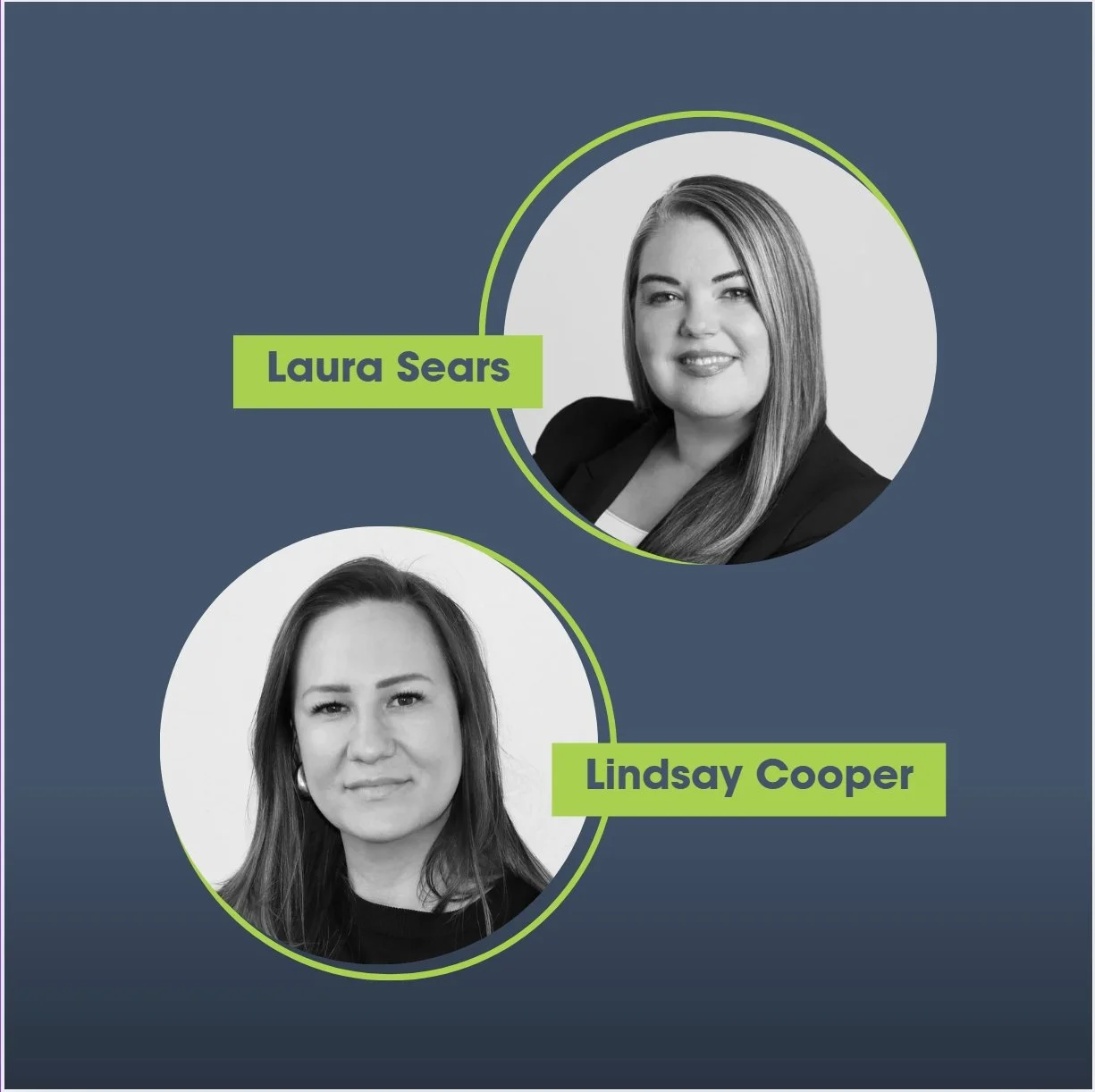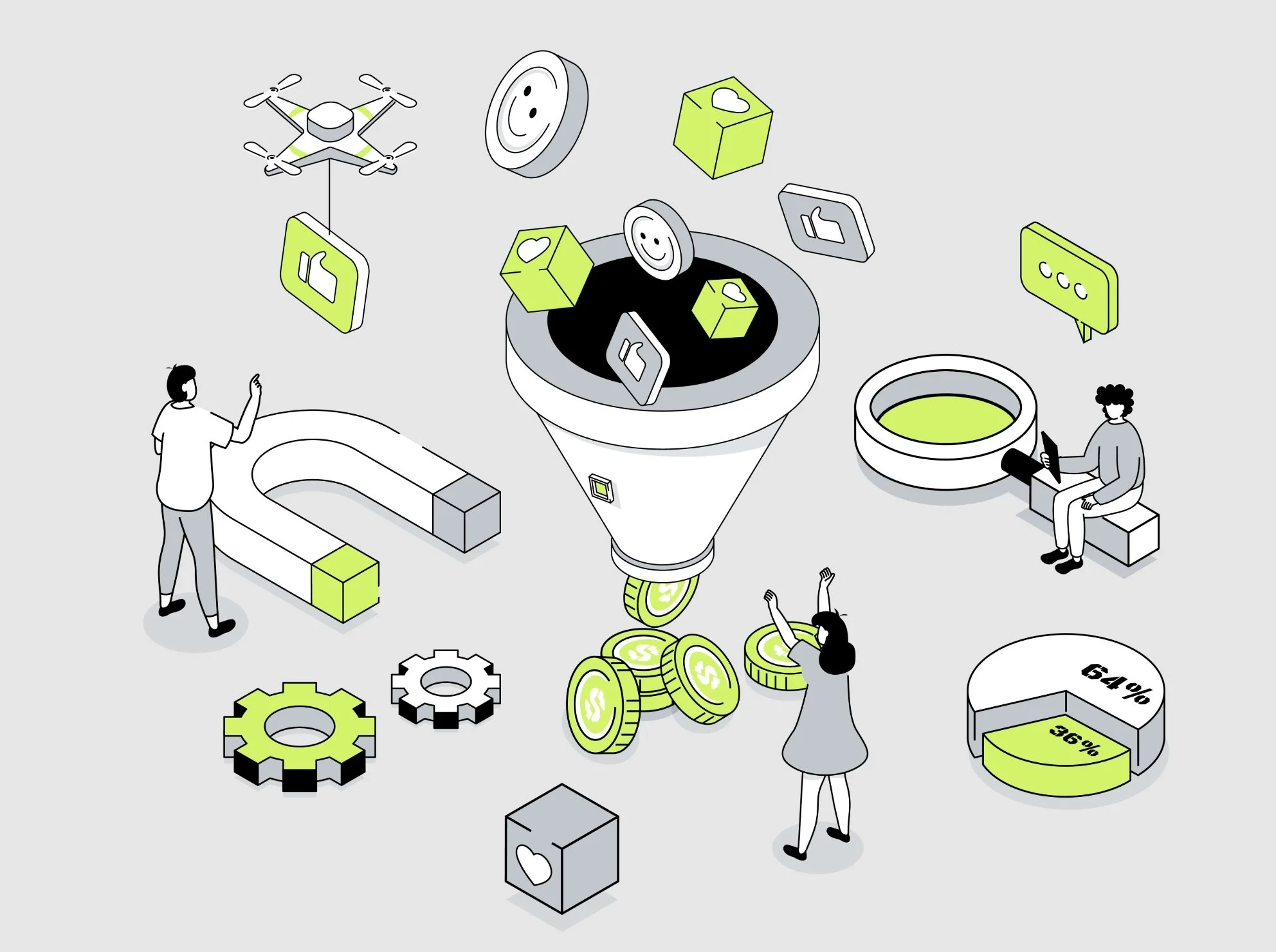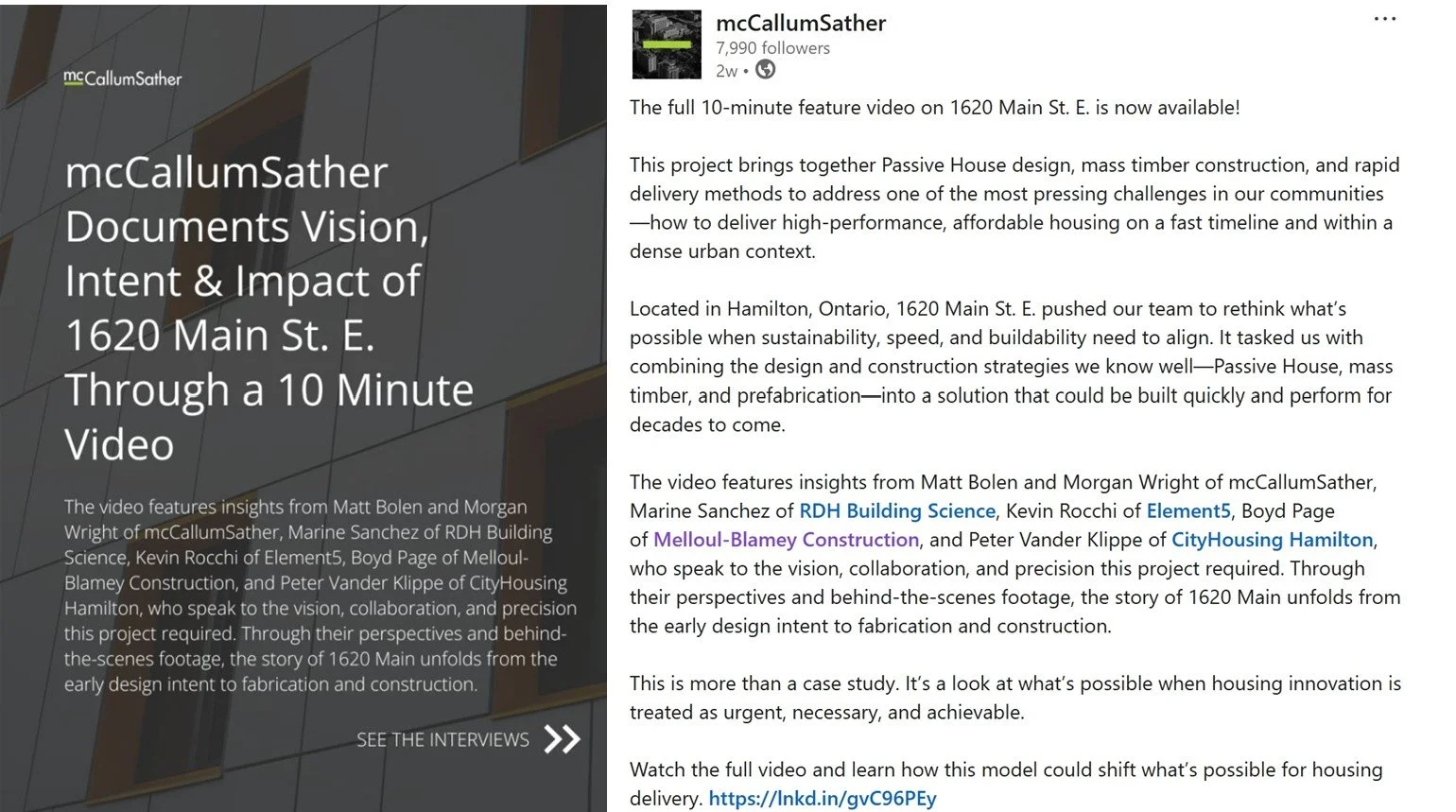From Behind-the-Scenes to the Architecture C-Suite
A CONVERSATION WITH LAURA SEARS AND LINDSAY COOPER ON STRATEGY, STORYTELLING, AND LEADERSHIP
In an industry defined by disruption, design innovation, and shifting market tides, the role of marketing and business development has never been more critical – or more complex. In this candid conversation, we sit down with Laura Sears, Principal of Business Development and Marketing at mcCallumSather, and Lindsay Cooper, Head of Business Development at Teeple Architects, two trailblazers reshaping how architecture firms tell their stories, build relationships, and position themselves for long-term success.
From the rise of data-driven strategy to refining storytelling, managing proposal workloads, and rethinking public speaking. Lindsay and Laura offer sharp insights, generous advice, and plenty of real-world examples on what’s working, what’s changing, and what needs to be reimagined in AEC marketing today.
Whether you're building a brand, refining your BD strategy, or looking for ways to elevate marketing's influence inside your firm, this conversation is packed with perspective, candour, and a whole lot of inspiration.
MORE THAN PROPOSALS: HOW MARKETING IS EVOLVING AT ARCHITECTURE FIRMS
Oomph: Marketing in the AEC industry has undergone significant change in recent years—shifting from a primarily proposal-focused function to a broader, more strategic role within firms. To start us off, where are you seeing the most meaningful shifts in how architecture firms are approaching marketing today? Are there practices that once felt novel or experimental that are now becoming the norm? And where do you see the greatest opportunities for continued growth or reinvention?
Laura: I joined McCallum Sather ten years ago from a legal background, just as marketing was starting to gain traction within the firm. While there were people focused on proposals, the idea of having a dedicated marketing team and approaching things from a broader strategic perspective was still emerging. Education – especially within leadership - was critical. We had to define what marketing really meant while building the systems to support it.
One of the biggest shifts came with data. We moved from an inward-facing approach to a client-centric one, steadily evolving how we collect, organize, and apply data to drive strategy. Today, data is a powerful tool – guiding decisions, delivering measurable results, and clearly demonstrating impact to leadership.
Lindsay: At Teeple, we’ve really been undergoing a transformation – not so much in terms of becoming present, because Teeple has always had a presence – but in clarifying and enhancing our relevance. As the industry and leadership evolve, we’ve focused on clarifying our unique value and telling a consistent, meaningful narrative through marketing, BD, and design leadership. Purposeful positioning now more than ever is central to how we operate. I see more firms moving this way – it’s becoming less about competition and more about collective impact. The real challenge? How do we maintain relevancy while adjusting our positioning.
BALANCING MARKETING AND BUSINESS DEVELOPMENT
Oomph: How have you managed the balancing act between marketing and the demands of business development—especially when proposals start to take over? Any strategies you can share?
Lindsay: The key is integration—marketing and BD shouldn’t operate in silos. A strong BD strategy makes proposal development more efficient and more strategic. At our firm, the same people often contribute across BD, proposals, and even project delivery, which fosters ownership and alignment. We focus on understanding the context of each opportunity, gathering intel early, and shaping our narrative in advance. That early collaboration helps us build the right teams, keep communication flowing, and reduce last-minute stress. When marketing, BD, and design are planning together, we’re not just reacting—we’re staying ahead. And when everyone’s engaged from the start, the proposal process becomes a shared, energized effort.
Laura: I can’t emphasize enough how important it’s been to integrate marketing and BD. We’re not selling a product—we’re selling long-term relationships. It’s about trust, collaboration, and guiding clients through often complex and emotionally charged journeys. That’s where storytelling becomes a powerful tool. We work closely with clients to build authentic narratives—through video, graphics, post-occupancy data, and writing. These stories become the foundation for proposals, making them more cohesive and emotionally resonant.
One of the best compliments I’ve received was from someone who said our proposal read like a novel they couldn’t put down. That’s the kind of connection we aim for—carried across proposals, social media, thought leadership, and PR. When everything aligns, the authenticity is evident, and that’s what really makes an impact.
Lindsay: Exactly—it’s about authenticity backed by consistency. From first meeting to final handoff, how we present our brand, our people, and our values should feel seamless and real.
PRE-POSITIONING AND SELECTIVITY AS STRATEGY
Oomph: Proposal strategy has evolved, with more emphasis now on pre-positioning—anticipating opportunities and aligning your team before the RFP even drops. That’s a major shift from the old “go after everything” approach. Have you seen that change in your own experience?
Lindsay: Absolutely. Earlier in my career, we chased everything—looking to stay visible and competitive. That scattershot approach felt necessary at the time, but with procurement evolving and competition growing more sophisticated, it’s no longer effective. Today, our focus is on being strategic and proactive. We rely on early intel—understanding the client, the opportunity, and the context—so we can decide where we’re truly well-positioned to succeed. That’s the essence of pre-positioning: starting with clear messaging early in the BD cycle, aligning our team, and shaping a narrative that carries through to the proposal. When we’ve done the work in advance, the submission becomes a continuation of a conversation—not a scramble. It’s helped us reduce fatigue, improve the quality of our responses, and be far more intentional about where we put our time and energy. That shift has been transformative.
Laura: That absolutely resonates. Pre-positioning is now foundational for us at McCallum Sather. We invest in gathering insights early—data, relationships, context—so when an opportunity does surface, we already have a strategy. We’ve also aligned our internal teams to collaborate well before the RFP stage. When that alignment is in place, our story is consistent across all channels—whether it’s a proposal, a social post, or a conference talk. That consistency builds trust and helps us stand out. Pre-positioning isn’t just about being prepared—it’s about showing up as the obvious choice.
TACTICS THAT WORK
Oomph: Tactics in this industry tend to come in waves. We’ve seen the industry shift their focus from PR to public speaking, and now social media. As tools evolve, some stick, others fade. Looking back, which tactics have stood the test of time for you? And which ones just don’t deliver anymore?
Laura: It’s an interesting question. We now have more tools and channels than ever before to reach clients in meaningful ways. Because we have a diverse practice—not focused on a single typology—we have to tailor our approach. Each client group engages with content differently. What resonates with a housing client might not work for a post-secondary or healthcare client. So we start by asking: What do they read? What influences them? What matters most?
That insight helps us build a tailored mix of tactics for each group. With limited resources, we have to be smart about where we invest our time—what’s going to deliver the most visibility and impact without burning out the team. It’s a balancing act between effectiveness and sustainability.
“But regardless of the tactic or channel, storytelling remains our most powerful tool. ”
And video has become an especially exciting medium for us. We’ve been fortunate to work with someone amazing who helps bring these stories to life in a way that’s collaborative and compelling—always centering the client. It’s about showing their journey, their vision, and making them the hero of the story. At the end of the day, whatever tactic we use—video, writing, PR—it all comes back to storytelling and strategy, and making sure we’re reaching people in ways that matter to them.
Lindsay: It’s very similar on our end. Storytelling and relationship building have always been at the core of what we do. We treat each project as a long-term relationship—not just a transaction. These projects leave a legacy of how our firm responds to unique challenges, people, and contexts.
The story doesn’t end when the project is complete. We focus on the full life cycle—how the project evolved with the client, the outcome, and the lasting impact on the community. That narrative then informs future work. We’ve built long-term relationships with institutions like Trent University and Langara College, and we use those experiences to demonstrate our ability to deliver meaningful, enduring results to new clients.
It’s not just about the medium—whether social media, conferences, or video—but about making sure the message is meaningful. We need to move away from constant, superficial content and instead highlight the real impact: how the spaces we create are used, valued, and remembered.
“The best feedback isn’t always an award—it’s hearing from someone who still loves using a building we designed 20 years ago. That kind of lasting connection is the story worth telling. It’s not about saying “look at us,” but “look at how this place has shaped people’s lives.”
Oomph: I love that! Capturing the long-term impact of buildings in a community could be one of the most powerful, underused storytelling tools we have!
Oomph: Let’s dig a little deeper. Newsletters and public speaking were once staples of AEC marketing but have largely fallen out of focus. Is it time to bring them back—and if so, how might they evolve in today’s social media landscape?
Laura: I think some tools we dropped during the rise of social media are starting to make a comeback. We’ve been discussing long-form, case-study-style newsletters again – not committed yet, but it’s on the table. People may not crave more reading, but with a strong hook, great visuals, and tight storytelling, you can still capture and maintain attention.
Public speaking has never left our toolkit. Our director, Matt Bolen, regularly presents across the U.S. and Canada. It’s a core part of how we reach new audiences and share authentic stories about our work and its community impact. For example, we’re speaking at RAIC this year about our sustainable library design. It’s not just visibility – it’s human-to-human connection and engagement opportunities. I can’t see that ever going out of our mix, it’s too powerful to leave behind.
Lindsay: As Teeple has grown, we’ve prioritized leveraging the different voices on our team to encourage inclusivity and diversity and to ensure that we are not saturating the market with a singular voice. Today, we use social media to promote our key leaders, to open doors for more speaking opportunities. But it’s not just our architects taking the mic anymore. We’re speaking alongside clients, engineers and consultants. By adding these voices we’re able to promote a holistic narrative of our projects and their impact beyond just their design. We’re giving audiences the full story. What was the client’s vision? How was it realized? Who made it possible?
In our work with Indigenous collaborators, the real story often starts long before pencil has gone to paper – with deep engagement and relationship-building. Focusing only on architecture can narrow the conversation. But when you spotlight the full journey, you reach a broader, more engaged audience.
Prioritizing the voices of different members within our firm and amongst our collaborators allows for the same project to be publicized in different ways. This way you’re capturing different angles of the project that you otherwise may not have been able to do.
SPEAKING UP, SMARTER: TAILORING MESSAGES TO DIVERSE AUDIENCES
Oomph: Too often, firms aim to speak at industry events filled with peers or competitors – but not the end users they’re designing for. If you’re working in education, why not present to educators? If it’s healthcare, why not speak to doctors? Shouldn’t we be telling our stories directly to prospects?
Laura: In addition to architectural audiences, we prioritize speaking directly to client groups – the ones our work impacts most – along with diverse audiences including government, designers, and consultants. Peer events are also incredibly important for us. Especially when it comes to helping our newer architects build confidence and grow comfortable in speaking about projects and handling tough questions. No matter the audience there is a value in getting out in front of people.
Lindsay: I agree with Laura – these conversations serve different purposes. If you're not speaking to your collaborators and competitors, we're missing the chance to evolve as an industry. We need to be sharing more with each other to learn and improve the built environment overall.
Historically, there’s been a fear in the industry around holding strong positions – but real growth comes from discourse, even if it challenges us. You’re not speaking to prove you’re the best – you’re speaking to share, learn, and be challenged. That feedback is what moves the conversation – and the industry – forward. Speaking is both marketing and business development, but it’s also continuing education for all of us.
The most valuable speaking opportunities are where we can engage with decision-makers, learn about upcoming work, and test ideas in the market. That’s where we invest our time and resources.
WEATHERING THE STORM: NAVIGATING MARKET DISRUPTION
Diversifying project types, geographies, and scales
Oomph: We’ve talked a lot about storytelling and strategy. Let’s turn now to the storm: our industry is facing massive disruption. Economic and sectoral upheavals, geopolitical curveballs, leadership transitions – they’re all hitting at once. Marketing and BD teams are on the front lines, helping firms adapt, communicate, and lead through uncertainty. And when budgets tighten or projects vanish overnight, we’re often expected to do more with less. As leaders steering through these choppy waters, what advice do you have for other marketers?
Lindsay: It really comes down to two things: brand consistency and adaptability. You need a strong brand that can weather market shifts, but you must also be willing to pivot. As the market changes, we’re constantly asking – where are there opportunities in the market? How do we position ourselves ahead of them? You can still stay true to your brand’s identity, its core strengths, all while beginning to diversity the range of projects you do to adapt to market needs. When work slows, we don’t stop – we learn. We visit projects, talk to clients, gather insight. That knowledge builds stronger strategies for when the market swings back up.
Laura: When McCallum Sather was founded in 1996, the focus was largely on affordable housing. But when government funding shifted, the leadership had the foresight to diversify the firm’s portfolio. Since then, we’ve maintained a broad range expertise as a strategy to protect growth. While the temptation to specialize has come up over the years, that diversity continues to serve us well as markets shift and sectors fluctuate. For instance, during the pandemic our range allowed us to experience new and unexpected opportunities in different geographies.
When evaluating pursuits, we use data to maintain a healthy mix: a range of project sizes, a balance across typologies, and consistent attention to high-performing sectors. Some years, housing may take the lead; in others, post-secondary or institutional work might rise.
“It’s about adjusting focus while maintaining equilibrium.”
FROM INVISIBLE TO INDISPENSABLE: ELEVATING MARKETING IN AEC FIRMS
Oomph: You've both shared how your firms have navigated change with resilience and foresight. What do you see as the biggest challenges facing marketing teams today—and how can they tackle them effectively? What advice would you give to marketers looking to re-vamp and empower their firms, especially in areas of opportunity where marketing isn’t yet fully recognized or valued?
Laura: Funny enough, my high school calculus teacher gave me one of the best pieces of career advice: show your work. Even if the answer’s not perfect, the thinking behind it matters. That’s something I’ve carried into my marketing leadership – transparency builds trust.
At McCallum Sather, we do a monthly report to leadership that covers not just win/loss and financials, but also PR, communications, and the broader impact of our efforts. It keeps marketing visible and valued. I’ve been fortunate to work with leaders like Joanne McCallum and Drew Hauser, who have always seen the value of marketing. But I’ve also been intentional – I made it clear from day one that I wanted to move from employee to principal to executive, and we created a plan to make that happen. That clarity and communication are key.
“Don’t be afraid to ask for a seat at the table – and back it up with results and insight. I’m also encouraged to see more marketers becoming associates, principals, and shareholders. We need more diverse voices at the top, especially during times of change. ”
Lindsay: Absolutely – it’s the same for us. As firms evolve, they need new types of insight at the decision-making table, especially from those who understand relationships, communication, and market realities. Marketing, BD, and PR professionals often bring a unique mix of empathy, creativity, and data-driven thinking that’s incredibly valuable in leadership.
The more versatile you are, the more resilient and indispensable you’ll be – especially in a market that’s always shifting. That’s how you earn a seat at the table – or even create one if it doesn’t exist yet.
“My advice to anyone starting out? Don’t box yourself into being just a coordinator, a writer, or someone who knows InDesign. Build a broad skill set. Say yes to new challenges, even if you don’t fully know how to do them – you might discover what you’re truly great at. ”
BUILDING A ROBUST MARKETING TEAM: TAKING CHANCES IN HIRING
Oomph: Expanding your skills and experience is essential, but it can be difficult within an AEC firm. Proposal work tends to dominate, often overshadowing other areas of marketing. And because the work is so specialized and complex, firms typically look for candidates with direct industry experience. As a result, many teams become highly skilled at proposals but lack broader marketing expertise—particularly in strategy.
That’s why I’ve always believed there’s real value in bringing in marketers from other sectors. They bring fresh thinking and transferable skills. The challenge, of course, is that most firms don’t have the capacity to onboard a marketer who can’t hit the ground running.
Lindsay: Willingness to learn is the most valuable skill in marketing and BD – hands down. Our team is small, and we often bring in recent architecture grads to spend a year in marketing before transitioning to design roles. They don’t always know what they’re interested in or good at yet, but they bring discipline, curiosity, and a strong work ethic fresh out of school. Honestly, they often outperform more experienced hires because they’re open. They’re not stuck thinking they already know it all – which can be a real barrier to growth. We’ve seen those early-career team members become some of our most valuable people. In contrast, when someone stops being curious or assumes they’ve learned everything, they’ve already hit their ceiling. Growth comes from staying open. Once you stop learning, you stop moving forward.
Oomph: Absolutely – we’re in a knowledge-based industry, and learning never stops. Laura, you recently hired someone from the film and entertainment world, and it’s paid off handsomely. She has brought a fresh set of marketing and PR skills that are producing fantastic story-driven content. A perfect example of why firms should make space for team members outside the industry. It can be a game-changer.
Laura: It’s been incredibly valuable. Sure, there was some initial intimidation – coming from film and PR into and architecture firm is a big leap. But her curiosity, eagerness to learn, and respect for the work made all the difference.
She quickly absorbed what she needed, and her strength in storytelling translated beautifully into proposals and all our other messaging. I really believe in looking outside the industry – there’s so much untapped talent out there. If someone shows up curious and excited to learn, I’m excited to work with them.
Lindsay: I think the easiest way to be successful in this industry is by believing in the ethos of your firm. It’s so much easier to do your job when you genuinely love the people, the projects, and the communities you serve. I don’t tell stories as an outsider – I’m emotionally invested. Like our University of Victoria National Centre for Indigenous Laws, in Victoria: hearing how it moved people during construction made me proud to share that story. Now it’s my story too, and I tell it every chance I get. When you believe in the work, sharing it doesn’t feel like marketing – it feels like advocacy. That passion is your straight shot to success.
Oomph: Any final pieces of advice?
Lindsay: One thing I’d add is the importance of your network in BD, marketing, and PR. Laura and I became great friends through this community, and those connections hold strong. It’s one of the most supportive corners of the industry I’ve ever worked in, and it makes what we do so rewarding.
Laura: I love that sentiment – it’s so true. At the core of everything we do is human-to-human connection. That gives us a deeper appreciation for the value of our networks and the richness they bring. It’s all about finding your people.






